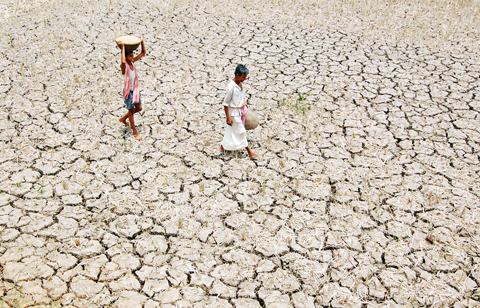Crops are shriveling as India faces the specter of drought, but economists say they are still upbeat about the country’s economic prospects.
They are banking that a strong industrial performance will help offset the impact of the worst monsoon in years in Asia’s third-largest economy.
Analysts have been buoyed by new data showing industrial production jumped by 7.8 percent in June from a year earlier — its quickest pace in 16 months.

PHOTO: AFP
Output was spurred by record low interest rates and government stimulus that have prompted consumers to purchase factory-made products such as cars and refrigerators.
The figures last week came on top of a slew of other economic indicators suggesting India is starting to rebound from the impact of the worst global downturn since the 1930s.
“The domestic economy is slowly but definitely reviving,” said Deepak Lalwani, India director at investment house Astaire & Partners in London.
Even with “the rain gods playing hooky,” a robust industry and service sector outlook “should offset the [economic] hit from agriculture,” said Rajeev Malik, economist at Macquarie Securities.
Malik said he was sticking to his forecast of 7 percent growth for the current fiscal year to March, although he said “a bigger hit to agriculture might warrant a downward revision.”
India’s economy expanded by 6.7 percent last year after growing by a scorching 9 percent for several years in a row.
HSBC economist Robert Prior-Wandesforde, who expects 6.2 percent growth, said the June industrial output number “suggests there is plenty of momentum” outside the agricultural sector.
He said there was “plenty more in the way of positive effects” to come from the central bank’s aggressive interest rate cuts and government stimulus.
“The upside from industrial activity [is] likely to mitigate the negative impact of poor rains,” Goldman Sachs analysts Tushar Poddar and Pranjul Bhandari wrote in a note to clients.
Economists’ optimism about overall prospects stems partly from the reduced role that agriculture now plays in India’s economy — accounting for around 17 percent of GDP, down from 50 percent in the 1950s.
For India’s 235 million farmers, many of them smallholders eking out a living, a single bad monsoon can spell financial disaster, wiping out livelihoods.
India’s official weather map is a mass of red — the color the weather office uses to show “deficient” rains, defined as 20 percent to 59 percent below normal.
Some 177 out of India’s 626 districts are in the grip of drought, with rice crops the worst hit. Only a thin strip along the western coast has received normal rain during this monsoon season, which runs from June to September.

WEAKER ACTIVITY: The sharpest deterioration was seen in the electronics and optical components sector, with the production index falling 13.2 points to 44.5 Taiwan’s manufacturing sector last month contracted for a second consecutive month, with the purchasing managers’ index (PMI) slipping to 48, reflecting ongoing caution over trade uncertainties, the Chung-Hua Institution for Economic Research (CIER, 中華經濟研究院) said yesterday. The decline reflects growing caution among companies amid uncertainty surrounding US tariffs, semiconductor duties and automotive import levies, and it is also likely linked to fading front-loading activity, CIER president Lien Hsien-ming (連賢明) said. “Some clients have started shifting orders to Southeast Asian countries where tariff regimes are already clear,” Lien told a news conference. Firms across the supply chain are also lowering stock levels to mitigate

IN THE AIR: While most companies said they were committed to North American operations, some added that production and costs would depend on the outcome of a US trade probe Leading local contract electronics makers Wistron Corp (緯創), Quanta Computer Inc (廣達), Inventec Corp (英業達) and Compal Electronics Inc (仁寶) are to maintain their North American expansion plans, despite Washington’s 20 percent tariff on Taiwanese goods. Wistron said it has long maintained a presence in the US, while distributing production across Taiwan, North America, Southeast Asia and Europe. The company is in talks with customers to align capacity with their site preferences, a company official told the Taipei Times by telephone on Friday. The company is still in talks with clients over who would bear the tariff costs, with the outcome pending further

Six Taiwanese companies, including contract chipmaker Taiwan Semiconductor Manufacturing Co (TSMC, 台積電), made the 2025 Fortune Global 500 list of the world’s largest firms by revenue. In a report published by New York-based Fortune magazine on Tuesday, Hon Hai Precision Industry Co (鴻海精密), also known as Foxconn Technology Group (富士康科技集團), ranked highest among Taiwanese firms, placing 28th with revenue of US$213.69 billion. Up 60 spots from last year, TSMC rose to No. 126 with US$90.16 billion in revenue, followed by Quanta Computer Inc (廣達) at 348th, Pegatron Corp (和碩) at 461st, CPC Corp, Taiwan (台灣中油) at 494th and Wistron Corp (緯創) at

NEGOTIATIONS: Semiconductors play an outsized role in Taiwan’s industrial and economic development and are a major driver of the Taiwan-US trade imbalance With US President Donald Trump threatening to impose tariffs on semiconductors, Taiwan is expected to face a significant challenge, as information and communications technology (ICT) products account for more than 70 percent of its exports to the US, Chung-Hua Institution for Economic Research (CIER, 中華經濟研究院) president Lien Hsien-ming (連賢明) said on Friday. Compared with other countries, semiconductors play a disproportionately large role in Taiwan’s industrial and economic development, Lien said. As the sixth-largest contributor to the US trade deficit, Taiwan recorded a US$73.9 billion trade surplus with the US last year — up from US$47.8 billion in 2023 — driven by strong